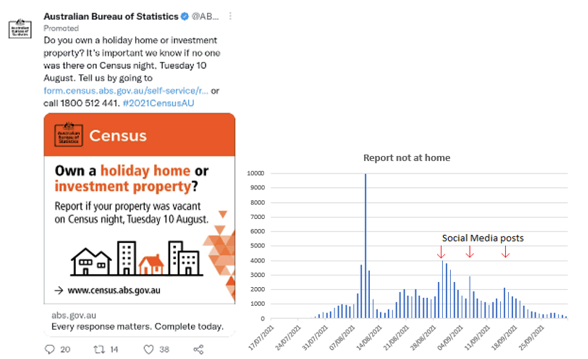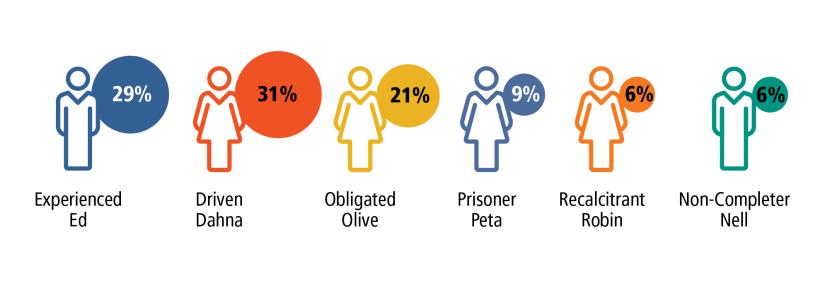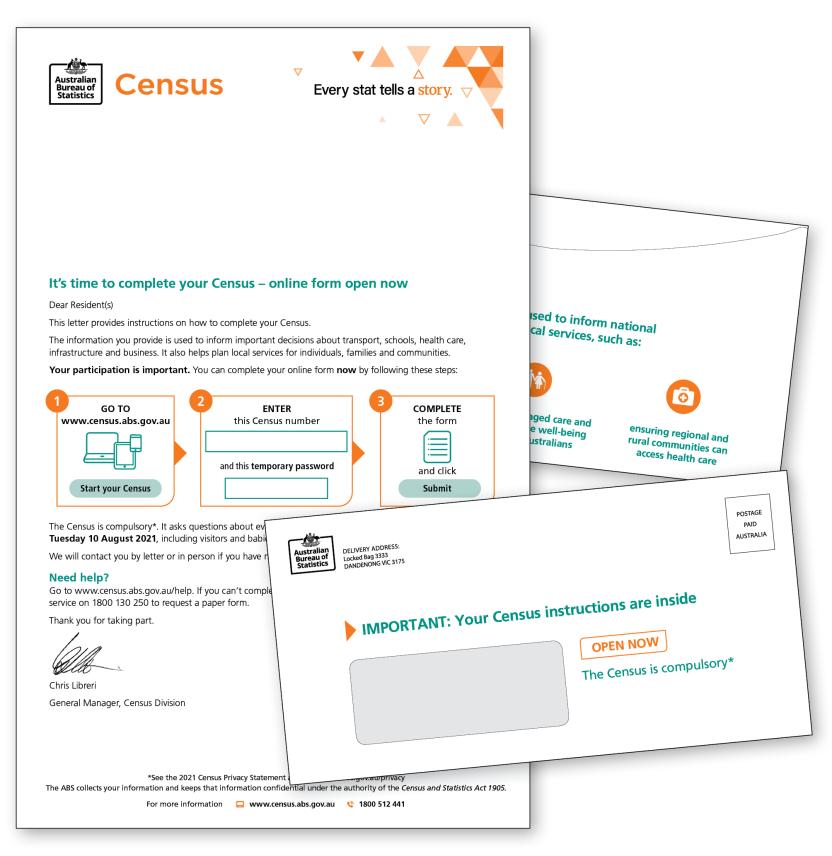Story 2: Communicating trust and value
Introduction
A national mass media campaign is an essential component of every Census, and this was more important than ever given the global pandemic environment in 2021. The objective of the campaign was to increase awareness of the Census and highlight its value to encourage informed and willing participation, therefore supporting the target 95% response rate.
The campaign was built on a long history of trust and participation by the Australian public in the Census. Further to this developmental research informed the campaign which aimed to educate people about how Census data is used to inform services for individuals, families and communities.
The advertising tagline, ‘Every stat tells a story’, was based on the idea that the Census is not just numbers, but what those numbers tell us to inform important decisions. Advertising agency BMF was engaged to develop the advertising creative.
Image
Description
Phases of our advertising and communication activities were closely aligned with the operational activity. The campaign focused on positively influencing people to complete the Census and contributed to a higher than forecast response by Census night and a high online take up at nearly 80%.
The ABS worked closely with the Service Delivery and Coordination Committee of Cabinet, with support from the Cabinet Advice Branch at the Department of Finance, to build flexibility into the Census campaign and receive the necessary government endorsement.
A phased advertising campaign ran between 4 July and 19 September 2021, and was coordinated with public relations, stakeholder engagement, and operational communications which ran between June 2020 and October 2021.
The 2021 Census communication campaign was rolled out in five phases:
- Phase one, establishing value (June 2020 – June 2021)
- Phase two, persuasion (4 – 27 July 2021)
- Phase three, completion (28 July – 12 August)
- Phase four, reminder (13 August – 19 September)
- Phase five, thank you (20 – 26 September)
Communication agencies 33 Creative and Etcom were engaged to adapt the mainstream campaign for Aboriginal and Torres Strait Islander peoples and CALD audiences respectively. Advertising was translated into 48 languages, including 19 Aboriginal and Torres Strait Islander languages.
The ABS engaged Universal McCann to manage the advertising placement across channels, including television, cinema, newspapers, radio, outdoor locations (buses and billboards), digital and social channels.

Our Story. Our Future.
The materials and resources for the Aboriginal and Torres Strait Islander audience featured the artwork ‘Our Story. Our Future.’
‘Our Story. Our Future.’ Was created by proud Wiradjuri, Wotjobaluk, Yuin and Gumbaynggirr artist Luke Penrith and Maluililgal people, Badu Island artist Naseli Tamwoy. It tells the story of how the ABS works with communities to see, hear and acknowledge Aboriginal and Torres Strait Islander peoples, cultures and experiences in our national story.
The artwork celebrates our stories being seen and heard for the benefit of future generations. It embraces the cultural importance of storytelling and information sharing, entwined with a focus on working together for a strong future for children, family and community.
The use of colours and inclusion of country, land and sea, rivers and desert, reflect the diversity of our peoples and culture across the country.

Results and impact
The 2021 Census campaign increased awareness of the Census.
- In 2021, 88% overall had heard something about the Census, awareness peaked at 98% between 9-15 August.
- In 2016, 76% overall had heard something about the Census (compared to 75% in 2011), awareness peaked at 86% around Census night.
The ABS commissioned Hall and Partners to undertake benchmark, tracking and evaluation research of the campaign. The phased advertising approach was highly successful, with strong and accurate message cut through. Those who had seen the campaign were generally better informed about the Census, held more positive attitudes and perceptions, and were more likely to have taken key actions such as completing the Census.
In other awareness raising activities:
- the media strategy included successfully delivering a Census press conference, hosted by the Hon Michael Sukkar MP, then ABS Minister, that increased awareness and coverage of the Census.
- a national spokesperson conducted over 200 media interviews during Census operations.
- supporting ABS spokespeople included 21 Aboriginal and/or Torres Strait Islander people, and 15 multilingual spokespeople speaking 17 different languages.
The proactive and strategic media engagement resulted in 41,038 media clips from 1 February to 19 September 2021 with a cumulative audience reach of 1.6 billion. Media sentiment across the Census coverage was 93% positive, trending positive or neutral.
More than 60 case studies were created and shared through media channels to highlight how Census data is used to inform services for communities.
Image
Description
Social media channels were a key component of communication and customer service support for the 2021 Census and for the first time we answered queries by a dedicated Social Media team. We resolved 85,000 engagements this way.
The social media strategy, including posts sponsored by the ABS, facilitated growth of the 2021 Census Facebook page from zero to 25,842 followers in six months. Misinformation, disinformation and malinformation were monitored through ’social listening’ to quickly address incorrect information about the Census.

Image

Description
Targeted social media
After Census night we used several social media posts to prompt action in slow to respond areas. We observed there was a low response in some holiday areas, so we developed this post to ask people who had empty second homes to tell us their dwellings were unoccupied. This paid social media activity led to improvements in response, with spikes in submissions of ‘report not at home’ occurring after each post.

Research
The ABS conducted research to inform the 2021 campaign and understand how communication and engagement activities could increase participation. It included audience segmentation research by Meld Studios and developmental research about attitudes, motivations and barriers to completion by Kantar Public.
Image

Description
The Census audience segments Meld Studios identified were:
- Experienced Ed – Motivated to complete but needs to know the Census is easy and secure to participate.
- Driven Dahna – Needs to know how to participate and that their information is secure.
- Obligated Olive – Understands the benefits of the Census to Australia and feels a sense of obligation to complete.
- Prisoner Peta – The fact that the Census is compulsory is their main motivation to complete it.
- Recalcitrant Robin – They see the Census as a waste of time and need to understand its importance.
- Non-completer Nell – Does not know much about the Census. They are motivated by being told it is easy and compulsory to participate.
The research informed messaging and strategy in developing the advertising campaign and reaching diverse audiences. The research informed three guiding principles to encourage people to participate in the Census including:
- educate people on the importance of the Census and how data is used
- highlight the benefit of completing the Census
- humanise and personalise the benefit, showing both individual and collective outcomes.
Contact materials
Contact materials such as Census Instruction Letters and envelopes were designed and tested with the Behavioural Economics Team of the Australian Government. Materials were designed and tested to encourage immediate action. Important elements of the materials included:
- an envelope that people would identify as important and requiring action
- messaging that the Census is compulsory
- wording that encouraged immediate action, including completing the form before Census night
- simple instructions on how to participate.
Testing included variations of materials provided to 40,000 respondents in the 2019 Census Test. This showed a greatly improved response from relatively minor changes to the instruction wording on both letters and envelopes. As an example, the messaging that the Census is compulsory drove action from people who were hard to engage or non-completers. It also made already willing participants feel more positive about completing the form. The wording on the envelope prompted more people to open it when it arrived.
Image
